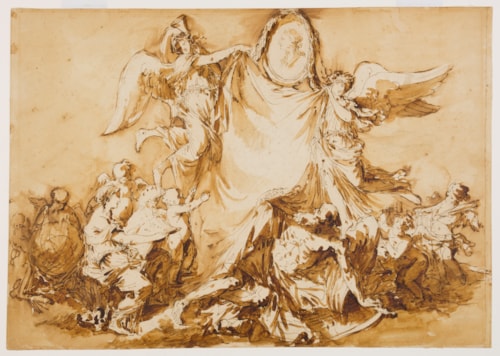
André-Jean LE BRUN
Paris 1757 - Vilnius 1811
Biography
A student of the sculptor Jean-Baptiste Pigalle, André Le Brun won the Prix de Rome for sculpture in 1756. He arrived in Rome in 1759 and, after his period as a pensionnaire at the Académie de France had ended, chose to remain in Italy. He achieved some success there, sculpting marble portrait busts of Pope Clement XIII and Cardinal Giuseppe Maria Ferroni, as well as a statue of Judith for the Roman church of San Marcello al Corso. Le Brun was never, in fact, to return to his native France. At the recommendation of his teacher Pigalle and the noted Parisian salonnière Mme. Geoffrin, Le Brun left Rome to enter the service of Stanislaw August Poniatowksi, King of Poland. He arrived in Warsaw in 1768 and spent several years working at the Royal Palace. Between 1775 and 1779 he was back in Rome, still working for the King of Poland and continuing his study of antique sculpture.
On his return to Warsaw, Le Brun was appointed First Sculptor to the King and head of the royal sculpture workshop. He provided sculptural decorations for the Royal Castle in Warsaw – most of which were lost in the destruction of the Castle during the Second World War, although it was later rebuilt - and other royal residences. In 1797 he accompanied Stanislaw August on his exile to Russia, and while in Saint Petersburg produced a number of sculpted portrait busts. Le Brun only left Russia in 1805, when he was appointed a professor at the University in Vilnius, a position he retained until his death there six years later.
Most of Le Brun’s extant corpus of drawings is in the museums of Warsaw, Cracow, Saint Petersburg and Budapest, and only a handful of sheets are to be found in collections in Western Europe and America. His drawings may be divided into two types; figure studies generally executed in red chalk and more complex compositions drawn in pen or brush with brown ink and a golden-brown wash, of which the present sheet is a particularly fine example. As a Russian scholar has noted of the artist’s compositional drawings of this type, ‘The originality of his pen and brush drawings permits us to place Le Brun among the outstanding French draughtsmen of the last three decades of the eighteenth century.’


